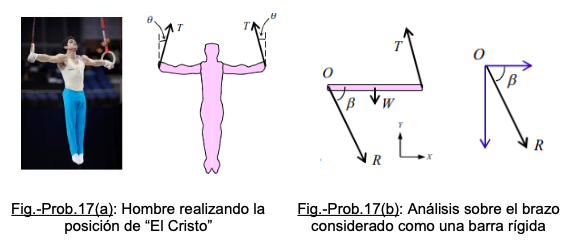An athlete of 60 kg and 1.70 m tall performs the ring exercise called "the Christ", in which he keeps his body immobile with his arms extended horizontally as shown in Fig.-Prob.17(a). The angle with the vertical of the cords from which the rings hang is theta = 10. (a) Determine the tension T in the cords holding the rings. (b) Considering each arm of the athlete as a rigid horizontal bar subjected to the forces indicated in Fig.-Prob.17(b), calculate the value of the components RX and RY, the value of the reaction “R” and of the beta angle. - W is the weight of the arm, applied in the middle of its length. - R is the reaction at the shoulder joint O. - RX and RY are the horizontal and vertical components respectively of the reaction applied at the shoulder joint O. - Note: Consider that the mass of each arm of the athlete is 3% of the total mass, and that the length of the arm is equal to 35% of its height. Fig.-Prob.17(a): Man performing the position of "The Christ" Fig.-Prob.17(b): Analysis on the arm considered as a rigid bar
An athlete of 60 kg and 1.70 m tall performs the ring exercise called "the Christ", in which he keeps his body immobile with his arms extended horizontally as shown in Fig.-Prob.17(a). The angle with the vertical of the cords from which the rings hang is theta = 10. (a) Determine the tension T in the cords holding the rings. (b) Considering each arm of the athlete as a rigid horizontal bar subjected to the forces indicated in Fig.-Prob.17(b), calculate the value of the components RX and RY, the value of the reaction “R” and of the beta angle.
- W is the weight of the arm, applied in the middle of its length.
- R is the reaction at the shoulder joint O.
- RX and RY are the horizontal and vertical components respectively of the reaction
applied at the shoulder joint O.
- Note: Consider that the mass of each arm of the athlete is 3% of the total mass, and that
the length of the arm is equal to 35% of its height.
Fig.-Prob.17(a): Man performing the position of "The Christ"
Fig.-Prob.17(b): Analysis on the arm considered as a rigid bar

Step by step
Solved in 2 steps with 2 images









